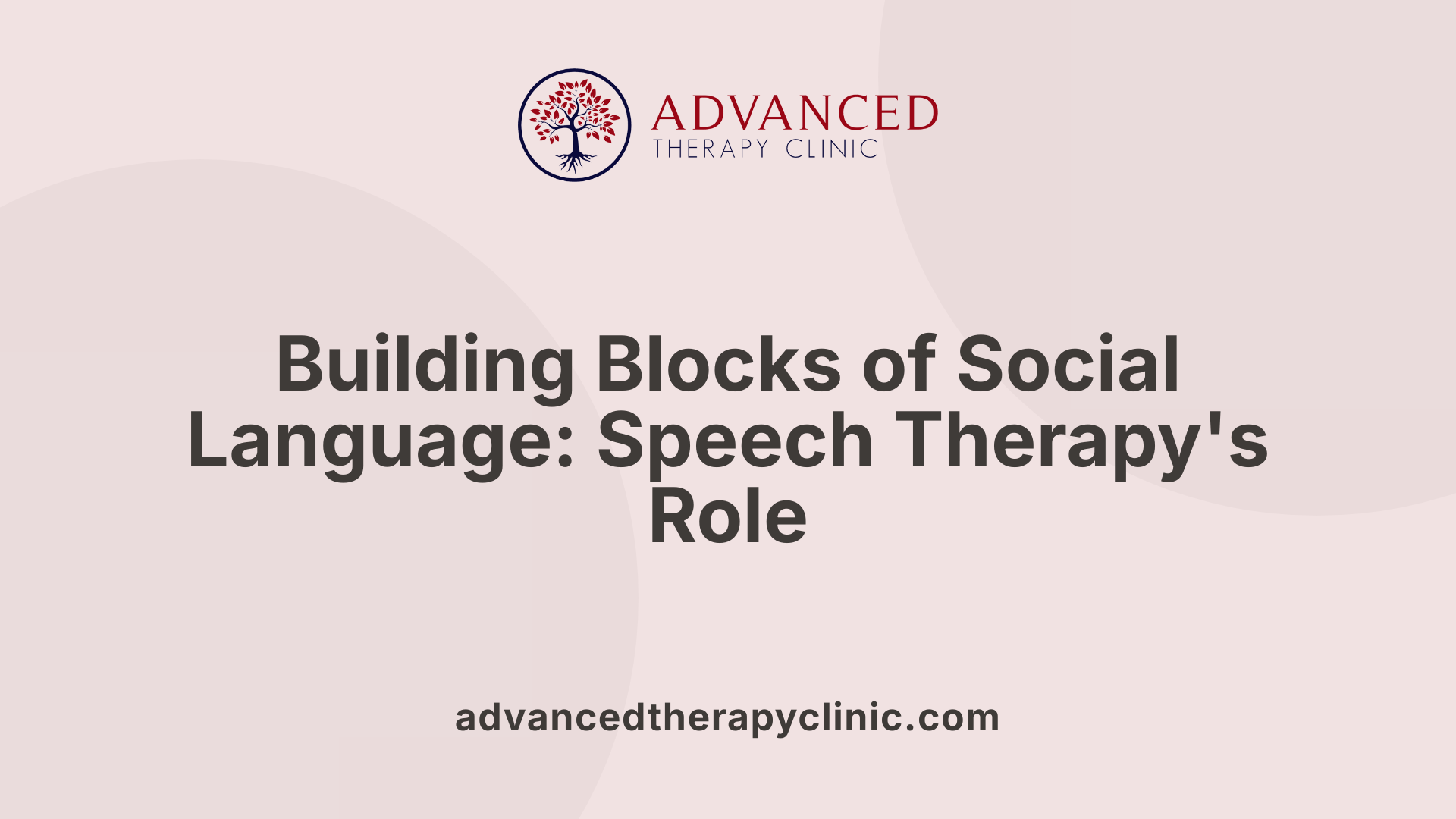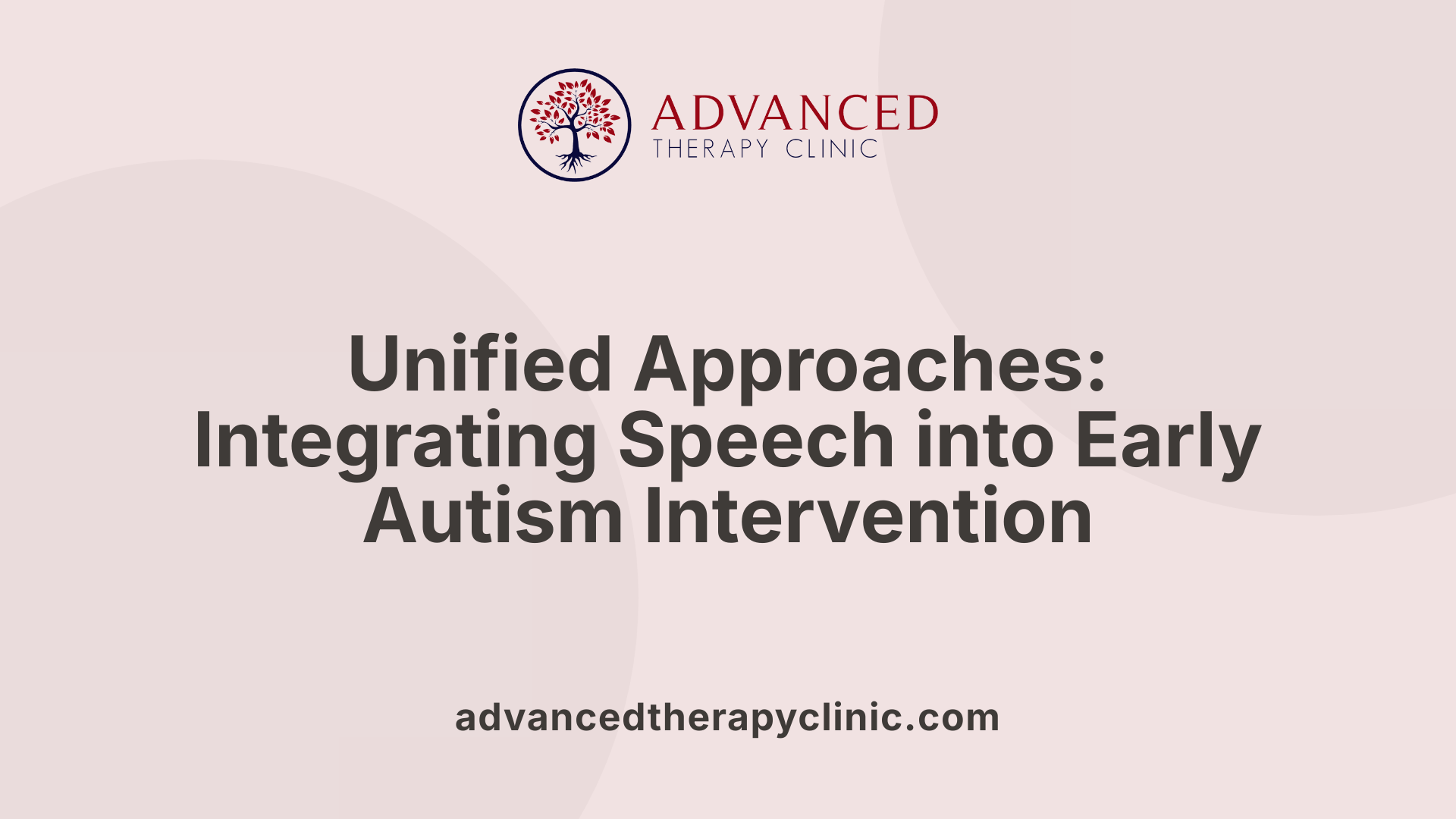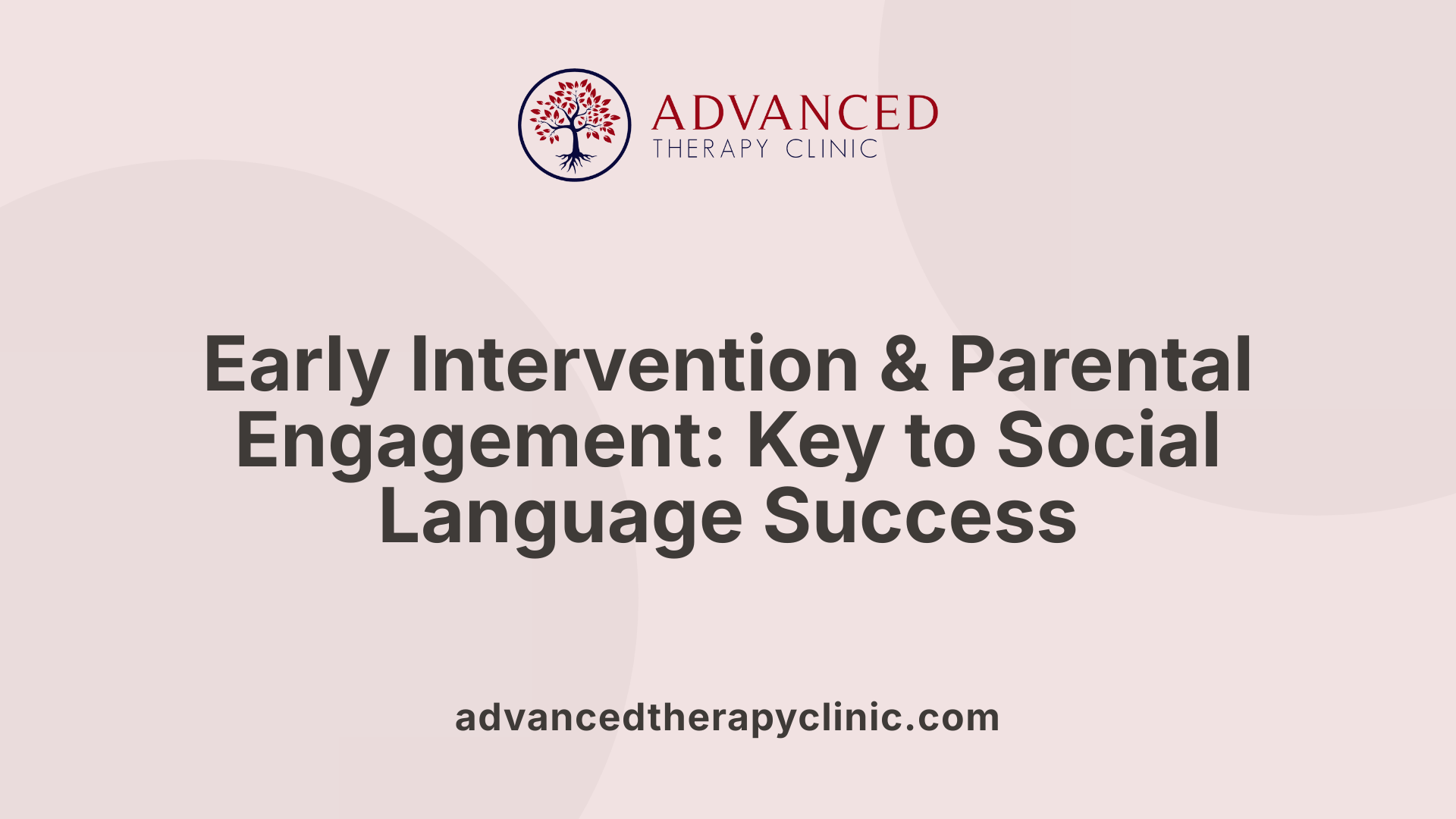The Role of Speech Therapy in Developing Social Language Skills


Understanding Speech Therapy's Vital Role in Social Communication
Speech therapy is a cornerstone in the treatment and support of individuals with communication challenges, particularly those with autism spectrum disorder (ASD) and related developmental conditions. This article explores how speech-language pathology enhances social language skills, the collaboration with other therapeutic fields, and the strategies that make these interventions successful in fostering communication, social engagement, and cognitive development.
Foundations of Speech Therapy in Enhancing Social Language Skills

What is the role of speech-language pathology in ASD and social language development?
Speech-language pathology (SLP) plays a crucial role in supporting children with Autism Spectrum Disorder (ASD) by targeting communication and social skills essential for social language development. SLPs assess, diagnose, and provide interventions that improve not only verbal communication but also nonverbal and social communication abilities. These interventions help children understand and effectively use language in social contexts, which is foundational to building better relationships and participating meaningfully in daily activities.
What strategies does speech therapy use to improve social language skills?
Speech therapy employs a variety of interactive and engaging strategies to enhance social language skills in children with ASD. Picture cues and tactile prompts assist with comprehension and expression, while articulation therapy targets speech clarity for better communication. Activities such as storytelling, role-playing, and structured play are integrated to build vocabulary and encourage expressive and receptive language development. These techniques also promote understanding of social cues, turn-taking, and appropriate conversational behaviors, all vital components of effective social communication.
Together, these methods provide a comprehensive approach to developing the social language skills necessary for children with ASD to thrive socially and academically. Early intervention and consistent practice, often supported by parental involvement at home, significantly improve outcomes in communication and self-esteem.
Speech Therapy Techniques Targeting Communication and Social Interaction

How does speech therapy address nonverbal communication and social cues?
Speech therapy plays a critical role in helping children interpret and use nonverbal communication effectively. Therapists focus on skills such as recognizing body language, maintaining appropriate eye contact, turn-taking during conversations, and understanding social cues. These abilities are essential for successful social interactions and are often targeted through guided social skills therapy and interactive games.
In what ways does speech therapy improve articulation and language clarity?
Speech therapists work to correct articulation disorders that can hinder speech clarity, thereby improving how well others understand the child. This is achieved through articulation therapy techniques tailored to the individual's needs.
Beyond articulation, speech therapy also enhances expressive and receptive language abilities. Expressive language skills are developed through structured activities like storytelling and language-building exercises, while receptive language skills—understanding others—are also nurtured. Role-playing and structured play support vocabulary growth and practical use of language.
Through these combined methods, speech therapy not only improves verbal communication but supports broader social communication skills necessary for meaningful interaction.
Additional techniques and their benefits
- Interactive games and storytelling: Engage children in natural language use and social dialogue.
- Role-playing: Encourages practicing social situations to improve conversational skills.
- At-home exercises: Involve parental participation, reinforcing skills outside therapy sessions.
Together, these speech therapy techniques provide a comprehensive approach to fostering communication and social interaction in children with autism and related disorders, promoting success in academic and social settings.
Integration of Speech Therapy Within Interdisciplinary Early Intervention

How does speech therapy collaborate with other therapies in early intervention?
Speech therapy closely partners with occupational therapy (OT), physical therapy (PT), Applied Behavior Analysis (ABA), and additional disciplines to comprehensively support a child’s development. This collaboration allows each specialty to contribute its strengths toward shared goals including improving communication, social interaction, cognitive abilities, motor skills, and behavioral regulation. For example, speech therapy focuses on language and communication skills, using techniques like storytelling, articulation therapy, and social communication strategies, while ABA targets the function and purpose of language in social contexts. OT supports sensory processing and fine motor skills, and PT advances gross motor development. By working together, therapists tailor interventions to meet the child’s unique developmental profile in natural environments.
Why is interdisciplinary collaboration important in autism treatment?
Interdisciplinary collaboration is critical to provide holistic and effective care for children with autism spectrum disorder (ASD). Through partnership among SLPs, OTs, PTs, ABA therapists, counselors, and nutritionists, treatment plans maintain consistency and reinforce progress in various developmental domains. This teamwork enhances outcomes by pooling diverse expertise, ensuring that interventions complement rather than contradict each other. Successful collaboration hinges on mutual respect and open communication, which help bridge differences in terminology and professional philosophies. Such coordinated approaches support the child’s overall well-being and skill acquisition more efficiently than isolated therapies.
What are the complementary roles of speech therapy and other fields?
Speech therapy enhances verbal and nonverbal communication, social language, and pragmatic skills essential for effective interaction. At the same time, occupational therapy improves motor and sensory abilities that support communication engagement. Physical therapy fosters mobility and physical independence, enabling active participation in social settings. ABA therapy strengthens socially significant skills, including communication and behavior, by applying behavior analytic principles. Together, these disciplines use integrated strategies like play-based learning and natural environment teaching, resulting in well-rounded development and greater engagement from children receiving early intervention for autism.
Play as a Catalyst for Social Language Development in Speech Therapy

Role of play in therapeutic settings
Play is a fundamental tool in speech therapy, serving as a natural and enjoyable medium for children to develop social language skills. Therapists use play to create engaging scenarios that encourage children to express themselves, practice vocabulary, and develop conversational abilities. Through play, therapy becomes less of a structured task and more of an interactive experience, fostering comfort and motivation.
Use of storytelling, games, role-playing
Speech-language pathologists incorporate storytelling, interactive games, and role-playing to promote language development and social engagement. Storytelling helps build vocabulary and sequencing skills, games stimulate turn-taking and expressive language, and role-playing allows children to practice social cues like eye contact and initiating dialogue. These playful activities provide repeated opportunities for language use in meaningful contexts.
Integration of play across therapies
Play is not limited to speech therapy; it is a central element across interdisciplinary therapies such as ABA and occupational therapy. ABA therapy uses play-based activities as motivators and teaching tools, while occupational therapy employs sensory bins, craft activities, and obstacle courses to aid fine motor and sensory processing skills. This integrated use of play ensures therapies align in strategy, enhancing the child's overall development.
Benefits of play in engagement and development
Incorporating play in therapy results in higher engagement from children, making learning enjoyable and effective. It supports emotional, cognitive, and physical growth by providing a holistic developmental framework. Moreover, play facilitates the generalization and maintenance of social and communication skills across different environments, a critical component of early intervention success.
Evidence-Based Practices in Speech Therapy and Its Synergy With ABA

What evidence supports the effectiveness of speech therapy in social language development?
Speech therapy is a well-established, evidence-based practice. Effectiveness is measured through detailed data collection, monitoring goal achievement, and observing improvements in key areas such as articulation, expressive and receptive language, and social communication skills. Speech therapists use techniques like articulation therapy, language intervention activities, and social skills training to enhance a child's ability to understand and use language effectively. This targeted approach helps children with autism spectrum disorder (ASD) develop stronger social language skills, which are critical for successful interpersonal interactions.
How do speech therapy and ABA complement each other?
Speech therapy and Applied Behavior Analysis (ABA) both rely on evidence-based methods, yet they focus on different aspects of communication and development. Speech therapy primarily addresses specific speech and language challenges, such as articulation, fluency, and language delays. ABA, on the other hand, concentrates on teaching the functional use and purpose of language within social and behavioral contexts. ABA employs behavior analytic principles to enhance communication by emphasizing how language functions in social interactions.
When combined, these therapies create a complementary approach that supports holistic development. Speech therapy strengthens the foundational language skills necessary for clear communication, while ABA builds on those skills to improve social use and functional communication. This synergy enhances not only language abilities but also social engagement, academic performance, and self-esteem in children with ASD.
Holistic developmental benefits of combining therapies
Integrating speech therapy with ABA leads to more comprehensive outcomes. The combined approach supports:
- Improved articulation and language clarity through structured speech techniques.
- Functional communication skills tailored to everyday social situations taught via ABA.
- Behavioral regulation and social skills development enhanced by reinforcement and naturalistic teaching methods.
- Increased engagement and motivation, often using play-based activities across both therapies.
Together, these therapies enable children to generalize learned skills across settings, improving participation in family, school, and social environments. This integrated model is supported by growing research and clinical practice, making it a highly effective strategy for supporting communication development in children with autism.
Early Intervention and Parental Involvement in Enhancing Social Language Skills

Why is early intervention critical in speech therapy for social language skills?
Early intervention in speech and language therapy plays a crucial role in improving communication abilities in children diagnosed with autism spectrum disorder and related conditions. Starting therapy as soon as diagnosis is confirmed allows children to develop strong social language skills at an early age. This early and intensive approach significantly boosts communication success, enhances self-esteem, and positively affects academic performance. Effective communication, encompassing both verbal and nonverbal skills like turn-taking and interpreting social cues, is foundational for meaningful social interactions and learning.
How does parental involvement support speech therapy outcomes?
Parents are vital collaborators in the speech therapy process. By engaging in at-home exercises and consistent practice aligned with therapy goals, families help reinforce what children learn during clinical sessions. This continued support fosters skill generalization, helping children apply communication skills across different settings and everyday situations. Parental involvement also encourages motivation and confidence, ensuring progress is maintained and maximized over time.
The broader impact of early and sustained intervention
Beyond speech clarity and vocabulary growth, early intervention contributes to children's holistic development. Improved communication skills allow better social integration and understanding of others' body language and social cues. When combined with other therapies like Applied Behavior Analysis (ABA) and occupational therapy, comprehensive early care promotes emotional, cognitive, and physical growth, driven by collaborative professionals and engaged families working together toward shared goals.
Future Directions: Enhancing Collaboration and Functional Outcomes

What models support successful collaboration among therapy disciplines?
Successful interdisciplinary collaboration in autism therapy relies on structured models that foster communication and mutual understanding among professionals. Decision trees serve as practical tools guiding therapists through assessment and intervention choices collaboratively, ensuring aligned treatment goals. Interprofessional training strategies further strengthen teamwork by educating speech therapists, ABA therapists, occupational therapists, and others on each discipline's expertise and terminology. This shared learning environment cultivates respect and smooth communication, bridging philosophical differences.
How is the focus on functional social language skills emphasized in therapy?
Therapy across disciplines places strong emphasis on developing functional social language skills that extend beyond clinical settings. Both ABA and speech therapy prioritize the generalization and maintenance of communication abilities, encouraging children to use language purposefully and effectively in daily social interactions. Techniques include teaching nonverbal cues, turn-taking, and interpreting body language, which are vital for meaningful engagement. These interventions ensure that gains translate into real-world social participation and improved relationships.
Enhancing functional, generalized social language skills through interdisciplinary approaches
An integrated therapy approach harnesses the strengths of ABA, speech therapy, and occupational therapy to promote holistic communication development. Through collaborative goal setting and consistent strategies across disciplines, children experience continuity in practicing social language skills within natural environments. Interprofessional communication models such as decision trees streamline intervention planning, while training initiatives build cohesive teams attuned to individual needs. This synergy ultimately supports children in navigating complex social landscapes with confidence and competence.
Speech Therapy: A Cornerstone for Social Language Mastery
Speech therapy plays an indispensable role in developing social language skills, vital for individuals with ASD and related conditions. By employing evidence-based techniques, integrating play, and collaborating closely with other therapeutic disciplines like ABA, occupational therapy, and physical therapy, speech-language pathologists create robust frameworks for communication growth. Early intervention further amplifies these benefits, particularly when parents actively participate in reinforcing therapy goals at home. Moving forward, enhanced interdisciplinary collaboration models promise even more effective support, ensuring the development of functional, generalized social language skills that empower individuals to thrive in their social worlds.
References
Recent articles

Expressive Speech Delay 2-Year-Old
Understanding and Addressing Expressive Speech Delay in Toddlers

How Speech Recognition Works
Unlocking the Power of Speech Recognition in Therapy and Healthcare

Autism and Head Size
Understanding the Complex Relationship Between Autism and Head Size

Occupational Therapy in Autism
Enhancing Independence and Quality of Life Through Occupational Therapy in Autism

Do Autistic People Understand Sarcasm?
Navigating the Nuances: Understanding Sarcasm and Social Communication in Autism

Autism Routines
Crafting Effective Daily Structures for Children with Autism


